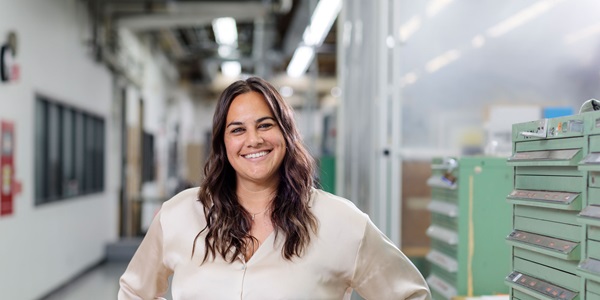Traci said Northrop Grumman's inclusive culture empowered her to share her authentic self.
One Heritage: A Proud History
Longtime PrIDA member Jon Eubanks reflects on the ERG’s journey.

By Jon Eubanks, as told to Caroline Briselli
When I joined Northrop Grumman heritage company TRW in 1997, I was the first successful recruit for GLAFnet, the Gay, Lesbian and Friends Network. GLAFnet was the Employee Resource Group predecessor to PrIDA and the industry’s first LGBTQ+ employee organization.
I’d started at my previous job in the aerospace industry in 1980, right out of the U.S. Navy. For my entire 15 years there, I was completely in the closet except with a few close colleagues, and I was looking for a more open environment. It’s hard to hide when you have a family and a husband, especially as the kids get older.
On day one at TRW, I decided that I would be out. What I found was that I was one of only a handful of people who were out at work. In GLAFnet, which had a huge membership for the time (50 members), a big proportion of our members — about 90% — were not out at work, and some weren’t even out in their personal lives. In the beginning, I was very lonely, but, as support grew, I discovered that we actually had a lot of allies, not just within leadership but in the general employee population. Engaging our allies really helped.
If I were to thank one person for founding our ERG, it’s John Green. John was an aerospace engineer at TRW who advocated for — and ultimately succeeded in achieving — government security clearance reform after losing his clearance because of his sexual orientation. After several attempts to form as a recognized ERG, John and a small group of employees founded GLAFnet on Oct. 31, 1996, just a few months before I joined the company.
It was a standout moment when Northrop Grumman acquired TRW in 2002. We were embraced by the company, with allies at Corporate championing the ERGs — including GLAFnet, which turned into PrIDA in 2010. I traveled around the country helping PrIDA chapters form, and it was helpful to get a good cross-section of what different cultures within the company were like, even when they were challenging. On one occasion, I was met by armed guards at one of our sites while opening a new chapter; there had been threats on my life and our executive sponsor’s life. Moments like this were kind of a shock, and this one in particular was eye-opening, but they were also learning experiences.
I always told leadership that, if they thought there was an opportunity for a teachable moment, I’d be happy to engage. For example, in the early years, I sometimes received hate emails at work and would often sit down with the email sender. I felt comfortable having these discussions, both because my dad, a minister, was a great role model for how to have difficult conversations and because I had support from company leadership. That support hardened my resolve to keep moving forward, educating and doing the work that we were doing.
Looking back, I feel a sense of pride that what we set out to do was accomplished, and it’s still continuing on today thanks to support from leadership, personal resolve and our Northrop Grumman Values. A lot of things that the company did, along with PrIDA leadership, made real, tangible, historic changes — including federal security clearance reform, which both TRW and Northrop Grumman were instrumental in — and moved the whole industry forward. We were the first LGBTQ+ ERG in the industry; today, we’re in friendly competition with our defense industry colleagues when it comes to diversity, equity and inclusion industry awards. And that same PrIDA chapter that kicked off under armed guards is now one of the most prolific and successful chapters in the whole company.
It’s been a journey — a challenging one, at times — but when I see where we are today, especially knowing where we came from, I’m proud of PrIDA’s legacy.
Interested in joining an Employee Resource Group? Learn about PrIDA and all of our ERGs.
Life at Northrop Grumman
Your work at Northrop Grumman makes a difference. Whether you want to design next-generation aircraft, harness digital technologies or build spacecraft that will return humanity to the moon, you’ll contribute to technology that’s transforming the world. Check out our career opportunities to see how you can help define possible.


